
Flamenco is an art form based on the various folkloric music traditions of southern Spain, developed within the gitano subculture of the region of Andalusia, and also having historical presence in Extremadura and Murcia. In a wider sense, the term is used to refer to a variety of both contemporary and traditional musical styles typical of southern Spain. Flamenco is closely associated to the gitanos of the Romani ethnicity who have contributed significantly to its origination and professionalization. However, its style is uniquely Andalusian and flamenco artists have historically included Spaniards of both gitano and non-gitano heritage.
The Music of Andalusia encompasses a range of traditional and modern musical genres which originate in the territory of Andalusia in southern Spain. The most famous are copla and flamenco, the latter being sometimes used as a portmanteau term for various regional musical traditions within Andalusia. Today, Andalusia has a rich and thriving musical scene, which draws from its own musical traditions as well as from external influences such as salsa, jazz or pop music.
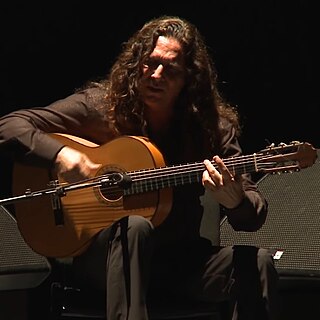
José Fernández Torres, known as Tomatito, is a Spanish roma flamenco guitarist and composer. Having started his career accompanying famed flamenco singer Camarón de la Isla, he has made a number of collaborative albums and six solo albums, two of which have won Latin Grammy Awards.

José Monje Cruz, better known by his stage name Camarón de la Isla, was a Spanish Romani flamenco singer. Considered one of the all-time greatest flamenco singers, he was noted for his collaborations with Paco de Lucía and Tomatito, and the three of them were of major importance to the revival of flamenco in the second half of the 20th century.

Vicente Amigo Girol is a Spanish flamenco composer and guitarist, born in Guadalcanal near Seville. He has played as an accompanying guitarist on recordings by flamenco singers Camarón de la Isla, and Luis de Córdoba, and he has acted as a producer for Remedios Amaya and José Mercé. His album Ciudad de las Ideas won the 2001 Latin Grammy for the Best Flamenco Album and the 2002 Ondas award for the best Flamenco work.
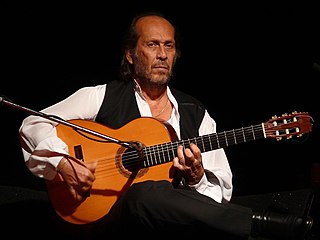
Francisco Sánchez Gómez, known as Paco de Lucía, was a Spanish virtuoso flamenco guitarist, composer, and record producer. A leading proponent of the new flamenco style, he was one of the first flamenco guitarists to branch into classical and jazz. Richard Chapman and Eric Clapton, authors of Guitar: Music, History, Players, describe de Lucía as a "titanic figure in the world of flamenco guitar", and Dennis Koster, author of Guitar Atlas, Flamenco, has referred to de Lucía as "one of history's greatest guitarists".
Al-Andalus Ensemble is a husband and wife musical duo that performed contemporary Andalusian music. The ensemble featured Tarik Banzi playing oud, ney and darbuka, and Julia Banzi on flamenco guitar.
The Romani in Spain, generally known by the endonym Calé, or the exonym gitanos, belong to the Iberian Romani subgroup known as Calé, with smaller populations in Portugal and in Southern France. Their sense of identity and cohesion stems from their shared value system, expressed among gitanos as las leyes gitanas.

Mayte Martín is a flamenco cantaora (singer), bolero singer, and composer.

Enrique Morente Cotelo, known as Enrique Morente, was a Spanish flamenco singer and a celebrated figure within the world of contemporary flamenco. After his orthodox beginnings, he plunged into experimentalism, writing new melodies for cante and jamming with musicians of all styles, without renouncing his roots in traditional flamenco singing, which he kept on cultivating despite criticism.
"It hasn't been easy. First came the accusations of corruption of the music, of treachery in his struggle to disfigure what was already perfectly coded. When some albums and some categorical evidence of his knowledge of the classical approach laid these malicious comments bare, then came the most twisted condemnations. That the pace of the compás waned, that he didn't really make you feel and that kind of thing."

La leyenda del tiempo is the tenth album by Spanish flamenco singer Camarón de la Isla, and the first one not to feature his long-time collaborator, guitarist Paco de Lucía. It is regarded as a turning point in the history of flamenco, contributing to the popularization of nuevo flamenco. A commercial failure due to its departure from traditional flamenco, which "scandalised purists", the album has received widespread critical acclaim.

Estrella Morente is a Spanish flamenco singer. She was born on 14 August 1980 in Las Gabias, Granada in southern Spain. She is the daughter of flamenco singer Enrique Morente and dancer Aurora Carbonell.
The cante flamenco, meaning "flamenco singing", is one of the three main components of flamenco, along with toque and baile (dance). Because the dancer is front and center in a flamenco performance, foreigners often assume the dance is the most important aspect of the art form — in fact, it is the cante which is the heart and soul of the genre. A cante singer is a cantaor or cantaora.
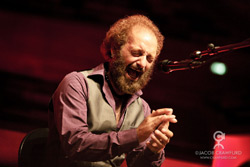
Juan Rafael Cortés Santiago, known as Duquende, is a Spanish Romani flamenco singer (cantaor). He is considered one of the successors to influential Flamenco singer Camarón de la Isla. Since 1997, Duquende has been a member of the Paco de Lucía Sextet in addition to working as a solo artist.

Carmen Pacheco Rodríguez, better known by her stage name Carmen Linares, is a Spanish flamenco singer.

Rafael Riqueni del Canto, is a Spanish guitar player and composer. He is considered as one of the biggest names or “Maestros” in flamenco guitar history. At age fourteen, he won the two main national awards for flamenco guitar in Spain. As an adult, he has won the most prestigious flamenco music awards in Spain, including: Premio Andalucía de Cultura, Premio Nacional de la Crítica, Giraldillo a la Maestría de la XVIII Bienal de Flamenco y el Premio AIE. In 2017, he was awarded with XXXI Compás del Cante, this award is always referred to by the Spanish media as the "Flamenco Nobel prize".

Javier Limón is a record producer, singer and songwriter born and raised in Madrid, Spain. Limón has worked with several artists, mainly from Spain, since he incorporates elements of flamenco rhythm to his work. Besides his work as producer has also dabbled as an interpreter and has released three studio albums, Limón, Son de Limón and Mujeres de Agua. Since 2003, Limón has done recordings in Israel, Bogotá, Bristol, Paris, Bahía Blanca, Buenos Aires, New York City and Morocco. In 2004, Limón was awarded the Latin Grammy Award for Producer of the Year for his work on Lágrimas Negras by Diego El Cigala and Bebo Valdés, Cositas Buenas by Paco de Lucía, El Cantante by Andrés Calamaro, El Pequeño Reloj by Enrique Morente, Niño Josele by Niño Josele and Tributo Flamenco A Don Juan Valderrama by Various Artists. Javier Limón serves as the Artistic Director of the Berklee College of Music's Mediterranean Music Institute, which operates in Valencia, Spain as well as Boston, Massachusetts.
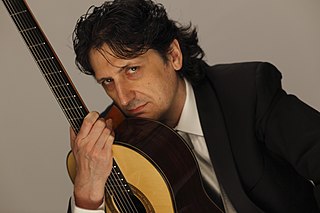
Juan Manuel Cañizares is a Spanish flamenco guitarist and composer. He is a winner of the "Premio Nacional de Música" (1982) and "Premio de la Música" (2008) awards.
Flamenco jazz is a style mixing flamenco and jazz. As flamenco artists in the 1960s and 1970s such as Paco de Lucia and Camarón de la Isla started experimenting with traditional music they had learned in childhood, a nuevo flamenco evolved.
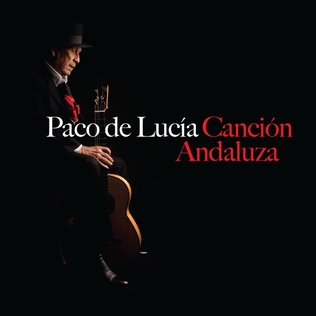
Canción Andaluza is the final studio album by Spanish musician Paco de Lucía, released on April 29, 2014 through Universal Music Spain. It was released posthumously after his death on February 25, 2014. Produced by de Lucía himself, it features collaborations with fellow Flamenco singers Estrella Morente and Vicente Castro "Parrita", and Venezuelan salsa musician Oscar D'León.















